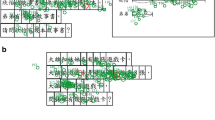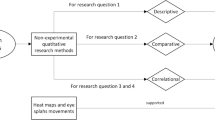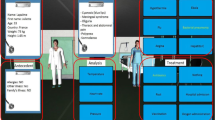Abstract
Eye tracking allows us to identify visual strategies through gaze behavior, which can help us understand how students process content. Furthermore, understanding which visual strategies are successful can help us improve educational materials that foster successful use of these visual strategies. Previous studies have demonstrated the predictive value of eye tracking for student performance. Chemistry is a highly visual domain, making it particularly appropriate to study visual strategies. Eye tracking also provides measures of pupil dilation that correlate with cognitive processes important to learning, but have not yet been assessed in any realistic learning environments. We examined the gaze behavior and pupil dilation of undergraduate students working with a specialized ITS for chemistry: Chem Tutor. Chem Tutor emphasizes visual learning by focusing specifically on graphical representations. We assessed the value of over 40 high-level gaze features along with measures of pupil diameter to predict student performance and learning gains across an entire chemistry problem set. We found that certain gaze features are strong predictors of performance, but less so of learning gains, while pupil diameter is marginally predictive of learning gains, but not performance. Further studies that assess pupil dilation with higher temporal precision will be necessary to draw conclusions about the limits of its predictive power.
Access this chapter
Tax calculation will be finalised at checkout
Purchases are for personal use only
Preview
Unable to display preview. Download preview PDF.
Similar content being viewed by others
References
Poole, A., Ball, L.J.: Eye Tracking in Human-Computer Interaction and Usability Research: Current Status and Future. Prospects. Chapter in Ghaoui, C. (Ed.) Encyclopedia of Human-Computer Interaction. Idea Group Inc, Pennsylvania (2005)
Tai, R.H., Loehr, J.F., Brigham, F.J.: An exploration of the use of eye-gaze tracking to study problem-solving on standardized science assessments. International journal of research & method in education. 29, 185–208 (2006)
Tsai, M.-J., Hou, H.-T., Lai, M.-L., Liu, W.-Y., Yang, F.-Y.: Visual attention for solving multiple-choice science problem: An eye-tracking analysis. Computers & Education. 58, 375–385 (2012)
Gluck, K.A., Anderson, J.R., Douglass, S.A.: Broader bandwidth in student modeling: what if ITS were ``Eye’’ TS? In: Gauthier, G., Frasson, C., VanLehn, K. (eds.) Intelligent Tutoring Systems, pp. 504–513. Springer, Berlin Heidelberg (2000)
Loboda, T.D., Brusilovsky, P.: User-adaptive explanatory program visualization: evaluation and insights from eye movements. User Model User-Adap Inter. 20, 191–226 (2010)
Conati, C., Jaques, N., Muir, M.: Understanding Attention to Adaptive Hints in Educational Games: An Eye-Tracking Study. Int J Artif Intell Educ. 23, 136–161 (2013)
Gomes, J.S., Yassine, M., Worsley, M., Blikstein, P.: Analysing Engineering Expertise of High School Students Using Eye Tracking and Multimodal Learning Analytics
Wu, H.-K., Shah, P.: Exploring visuospatial thinking in chemistry learning. Sci. Ed. 88, 465–492 (2004)
Beatty, J.: Task-evoked pupillary responses, processing load, and the structure of processing resources. Psychological bulletin. 91, 276 (1982)
Zekveld, A.A., Festen, J.M., Kramer, S.E.: Task difficulty differentially affects two measures of processing load: The pupil response during sentence processing and delayed cued recall of the sentences. Journal of Speech, Language, and Hearing Research. 56, 1156–1165 (2013)
Bornemann, B., Foth, M., Horn, J., Ries, J., Warmuth, E., Wartenburger, I., van der Meer, E.: Mathematical cognition: individual differences in resource allocation. ZDM 42, 555–567 (2010)
Wierda, S.M., van Rijn, H., Taatgen, N.A., Martens, S.: Pupil dilation deconvolution reveals the dynamics of attention at high temporal resolution. Proceedings of the National Academy of Sciences 109, 8456–8460 (2012)
Paas, F., Renkl, A., Sweller, J.: Cognitive load theory and instructional design: Recent developments. Educational psychologist 38, 1–4 (2003)
Schultheis, H., Jameson, A.: Assessing cognitive load in adaptive hypermedia systems: physiological and behavioral methods. In: De Bra, P.M., Nejdl, W. (eds.) AH 2004. LNCS, vol. 3137, pp. 225–234. Springer, Heidelberg (2004)
Conati, C., Merten, C.: Eye-tracking for user modeling in exploratory learning environments: An empirical evaluation. Knowledge-Based Systems. 20, 557–574 (2007)
Iqbal, S.T., Bailey, B.P.: Using eye gaze patterns to identify user tasks. The Grace Hopper Celebration of Women in Computing, pp. 5–10 (2004)
Rau, M.A., Michaelis, J.E., Fay, N.: Connection making between multiple graphical representations: A multi-methods approach for domain-specific grounding of an intelligent tutoring system for chemistry. Computers & Education 82, 460–485 (2015)
Johnson, C.I., Mayer, R.E.: An eye movement analysis of the spatial contiguity effect in multimedia learning. Journal of Experimental Psychology: Applied 18, 178 (2012)
Mason, L., Pluchino, P., Tornatora, M.C.: Effects of picture labeling on science text processing and learning: Evidence from eye movements. Reading Research Quarterly 48, 199–214 (2013)
Koedinger, K.R., Baker, R.Sj., Cunningham, K., Skogsholm, A., Leber, B., Stamper, J.: A data repository for the EDM community: The PSLC DataShop. Handbook of educational data mining 43 (2010)
Ainsworth, S.: DeFT: A conceptual framework for considering learning with multiple representations. Learning and Instruction 16, 183–198 (2006)
Author information
Authors and Affiliations
Corresponding author
Editor information
Editors and Affiliations
Rights and permissions
Copyright information
© 2015 Springer International Publishing Switzerland
About this paper
Cite this paper
Peterson, J., Pardos, Z., Rau, M., Swigart, A., Gerber, C., McKinsey, J. (2015). Understanding Student Success in Chemistry Using Gaze Tracking and Pupillometry. In: Conati, C., Heffernan, N., Mitrovic, A., Verdejo, M. (eds) Artificial Intelligence in Education. AIED 2015. Lecture Notes in Computer Science(), vol 9112. Springer, Cham. https://doi.org/10.1007/978-3-319-19773-9_36
Download citation
DOI: https://doi.org/10.1007/978-3-319-19773-9_36
Published:
Publisher Name: Springer, Cham
Print ISBN: 978-3-319-19772-2
Online ISBN: 978-3-319-19773-9
eBook Packages: Computer ScienceComputer Science (R0)




